.
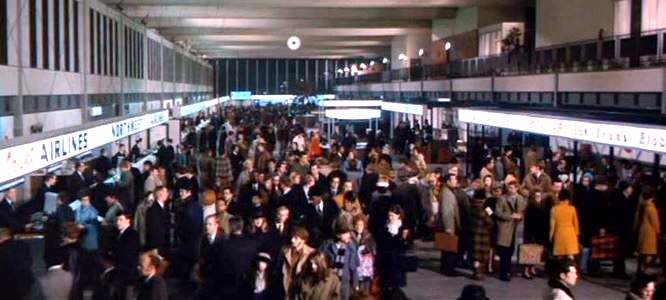
Directors: George Seaton, Jack Smight, Jerry Jameson, David Lowell Rich
By Roderick Heath
For several decades, Bedfordshire-born Arthur Hailey was the definition of a successful, immensely popular author. Hailey purportedly sold more than 170 million books with his patented brand, turning stringent research on spheres of life charged with yearning fascination for the public at large—politics, five-star hotels, high finance, and most enticingly, the new age of jet travel. One of Hailey’s earliest successes was a teleplay written for Canadian TV, Flight Into Danger, depicting the chaotic results of an outbreak of food poisoning on a transcontinental airliner; it was quickly adapted into a 1957 feature film called Zero Hour. Hailey revisited this territory with his 1968 novel Airport, which became a colossal bestseller, informing his readers about a scene quickly becoming mundane and yet still imbued with an aura of romance and exclusivity. Airport thrilled with the privilege of seeing that world’s inner workings, mixed with racy glimpses into the burgeoning sexual revolution as it affected not just the dashing wayfarers of the sky, but also the earthbound functionaries of airport administration. Airport was brought to the big screen in 1970 in the midst of what is seen today as a transformative moment in cinema history, as the old studios were teetering and a new breed of filmmaker was beginning to make headway in the industry.
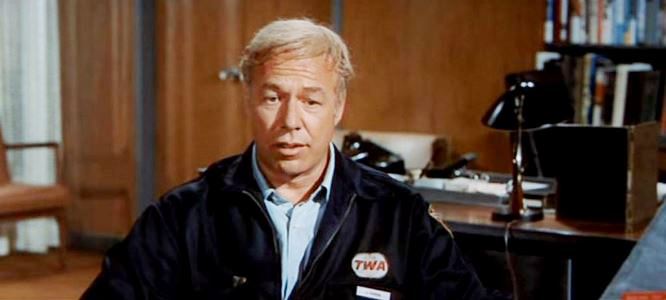
Airport’s success in its time stood as a reminder that even in the days of Easy Rider (1969) and MASH (1970), old-fashioned Hollywood values still held power. The project was shepherded with Selznickian ambition by producer Ross Hunter, backed up by high production values and, most importantly, a battery of strong stars cultivated from several generations of Hollywood actor. The recent death of George Kennedy at a very ripe old age put the Airport films back in my mind. Kennedy, big, burly, and balding, was nobody’s idea of a traditional leading man, and yet he and his character, Joe Patroni, became the linchpin for this, one of the first true modern film franchises. Kennedy, well known to filmgoers after his Oscar-winning turn in Cool Hand Luke (1967), was cast as Patroni, initially a TWA mechanical troubleshooter, but soon, in the course of the series, to be kicked upstairs as an airline executive, and later, barnstorming pilot, still bringing arch masculinity and cussed grit to any situation.

The setting of Airport is Lincoln International Airport, based on Chicago’s O’Hare International, beset by Christmas traffic and a powerful blizzard. During the opening scenes, a pilot bringing a 707 into the airport manages to get the plane bogged in snow when trying to taxi, effectively blocking Runway 29 and forcing airport manager Mel Bakersfeld (Burt Lancaster) to close it down. This stirs up manifold troubles for Mel: holiday passengers complain, as do citizens of a suburb right under the alternate runway, as Mel has broken his promise not to use that runway after dark. As the night progresses, Mel sets Patroni on the job of moving the ditched aircraft, fends off angry protesters and airport trustees, deals with an elderly habitual stowaway, Ada Quonsett (Helen Hayes), and is forced to manage an ever-escalating crisis involving a passenger, Guerrero (Van Heflin), who wants to blow himself up along with Rome-bound flight The Golden Argosy for insurance money.

Meanwhile everybody’s private life is in a state of flux. Mel’s marriage to Cindy (Dana Wynter) is falling apart because of his dedication to his job, a process sped up by one of their daughters, tired of their fights, running off from home. Cindy eventually admits to having an affair, and Mel himself is increasingly drawn to indefatigable airline customer relations honcho Tanya Livingston (Jean Seberg). Mel’s sister, Sarah (Barbara Hale), is married to pilot Vernon Demarest (Dean Martin), a serial romancer who’s currently having an affair with flight attendant Gwen Meighen (Jacqueline Bisset): Gwen reveals to Vernon she’s pregnant, and in spite of Sarah’s confident expectations that Vernon will always come back to her, he is seriously affected by Gwen’s news and begins contemplating a life with her. Meanwhile Guerrero’s distraught wife, Inez (Maureen Stapleton), comes into the airport looking for her husband. Alerted to his plan, Vernon, Gwen, and Quonsett, who escaped her minders and boarded the Argosy, use a ruse to snatch Guerrero’s dynamite-filled briefcase away from him, but they’re foiled by another passenger. Guerrero detonates the bomb, leaving Gwen badly injured and forcing the plane’s pilot, Anson Harris (Barry Nelson), to turn back and make a dangerous landing—a landing that can only take place if Patroni can get Runway 29 cleared in time.
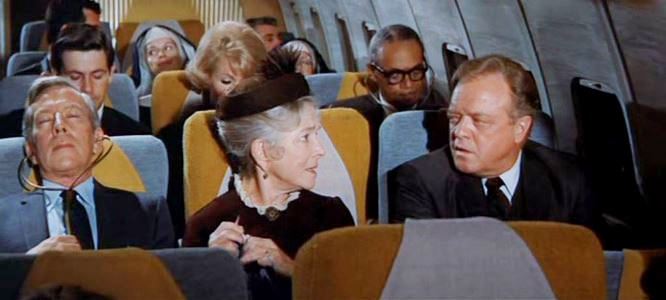
Hailey’s disaster narrative owed a lot to Ernest K. Gann’s The High and the Mighty, which had been filmed by William Wellman to great effect in 1956. Writer-director George Seaton whittled down a lot of the discursions into the business and politicking of Mel’s job, as well as the sidelong lunges into soft-core territory that helped make Hailey’s book so popular, to concentrate on the major drama of Guerrero’s crazed mission. In the process, Seaton gave real impetus to a film genre for which The High and the Mighty had been ür-text: the disaster movie in which a number of motley types are placed into a situation of common danger from a deus-ex-machina calamity. Film screens in the next decade would be clogged with these films in both the subsequent Airport films and the more extravagant productions of Irwin Allen. Common to most was the emphasis on the “all-star cast,” ensembles combining dependable headliners, good-looking ingénues, fashionable faces of the moment, and a smattering of older, once very famous actors to lend a touch of class and nostalgic pep. There was an irony built into this formula, as the appeal of these films depended on employing veteran actors, only to kill them off per the demands of the narratives, as if Hollywood, in perpetuating itself, was employing its old troupers and hardy survivors as a kind of spiritual Soylent Green. Hayes’ witty, scene-stealing performance in Airport helped create this template and perhaps created something of an archetype familiar today—the geriatric who refuses to conform to type, happily indulging herself and using her age as a weapon to stave off prosecution and punishment.
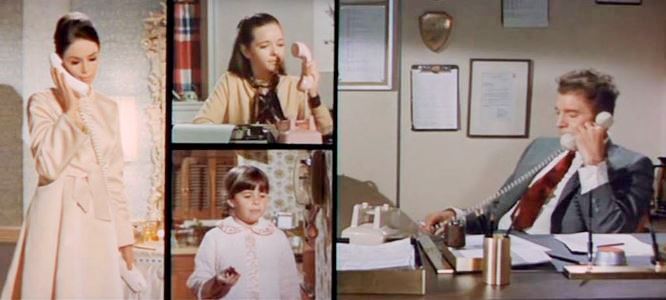
Hunter and Seaton were both old Hollywood pros, exactly the sorts of people who were supposed to be irrelevant by this time. Seaton had worked on A Night at the Opera (1935) and A Day at the Races (1936) for the Marx Brothers and later made the perennial Miracle on 34th Street (1947). With Airport, Hunter saw the ultimate proof of his own thesis, offered earlier when he produced Douglas Sirk’s lush melodramas, that the vicarious thrills of luxury and flash still had enormous appeal for filmgoers amidst all the washed-out denim of the period. It was also the final project for composer Alfred Newman, whose achievements included writing the famous 20th Century Fox fanfare. The overlit interiors and rather bland colour palette, as well as the often cheap look of sets, recalls similar faults with a lot of studio filmmaking of the period, one reason many said that in spite of the budgets and assembly-line production arts Hollywood still wielded at the time, the quality of its craftsmanship was slipping. Seaton’s direction imported some modish tricks to jazz the film up, like some split-screen effects that work well, although when he uses this style during Mel’s conversations with his family over the phone, the effect echoes rather amusingly of The Brady Bunch.
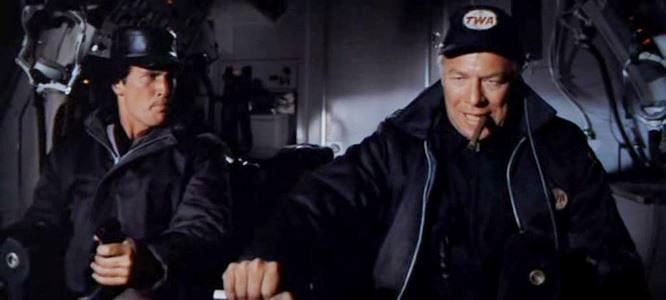
The thing that differentiates Airport from something that could have been made 15 years earlier was its reflection on shifting social mores. The first film wields an essentially nonmoralistic take on characters whose sex and emotional lives are becoming increasingly unconventional. The relatively calm, even auspicious sense that comes upon Mel and Cindy when they finally agree to divorce and pursue more satisfying relationships still has a faintly radical ring, even though the fact Cindy’s characterised as a shrieking harpy cops out a bit. This also goes for Vernon and Gwen’s relationship, although there’s a slight taste of something retrograde when gorgeous, spunky, quick-witted Gwen gets mangled by the bomb. The conscious equation of aircraft with sexuality is taken to amusingly hyperbolic lengths by the finale, as Patroni, desperate to gun the 707 out of the way, bellows at the plane “Either way, she’s gonna get it,” like a frustrated, but determined man trying to get a particularly uncooperative G-spot off. As the series unfolded, the more it embraced this louche, glossy magazine ad-like take on adult sexuality. The film’s punch line, with Mel grinning at Tanya and essentially proposing they dive straight in the sack with the deathless line, “You’ve been bragging about your scrambled eggs,” sets the seal. The official message of the Airport series is that though the age of mass commercial flight can be an aggravating and occasionally dangerous business, a whole infrastructure of human and mechanical resource will be brought to bear if and when things go wrong. The unofficial message is that everyone should stop fretting and just get down with it.
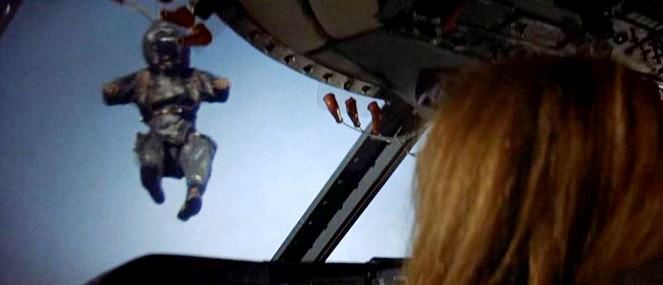
Airport is still very entertaining and dramatically solid, for all its plastic-fantastic points, barrelling along with Seaton’s real storytelling savvy and utilising its excellent cast with a finite sense of what they bring to the table, particularly Hayes’ perky, elfin humour, Stapleton’s clammy panic, Bisset’s foxy poise, and Kennedy’s macho heft. Others don’t work so well, like Martin, who seems rather fuzzy throughout playing a character seemingly perfect for him. Occasionally the film lurches into real silliness, like a priest slapping an annoying passenger during landing, laying the seeds for some of the intense goofiness to come in the sequels. Airport grossed more than $100 million, a staggering sum for 1970, and small wonder every producer and his dog got busy imitating it. Hunter crash-landed making 1973’s atrocious Lost Horizon remake, and the series was handled from then on by Jennings Lang and William Frye, who provided a follow-up on the relative cheap four years after the original under the hopeful title of Airport 1975. It’s worth noting at this point that despite incredible popularity of the Airport films, now they’re probably known far less well than one of their cultural by-products, Jim Abrahams and David and Jerry Zucker’s send-up, Airplane! (1980), which borrowed tropes from all of the films and Zero Hour for a merciless ribbing. Airport 1975 serves up several of the most memorable elements Airplane! spoofed—the wonder of it is that the original might actually be sillier.

Airport 1975, the second entry in the series, feels more like the 15th in the way it takes only essential elements from the original and riffs on them with a tone that can’t be called self-satirising, but certainly with a rather puckish, can-you-believe-we’re-pulling-this-trick? smirk. Screenwriter Don Ingalls sets up the most bare-boned take on the series’ basic plot: placing a raft of quickly sketched characters played by assorted well-known faces in danger during a mid-air emergency. Some aspects of the original film are recycled studiously. The theme of romance between a pilot and his sturdy, but nettled stewardess is as compulsory as Patroni’s presence in the series, here in the form of Charlton Heston’s executive swashbuckler Alan Murdock and Karen Black’s indefatigable Nancy Pryor. Near-disaster is again caused by someone trying to keep up in the rat race, although Dana Andrews’ hapless salesman only accidentally collides his light plane with a 747, killing flight crew members Roy Thinnes and Erik Estrada and severely injuring captain Efrem Zimbalist Jr. Passengers on this troubled flight include Linda Blair, fresh off The Exorcist (1973), as a deathly ill transplant candidate, Myrna Loy as a wandering widow fond of boilermakers, Sid Caesar as an easily startled would-be romancer, Norman Fell and Jerry Stiller as a couple of stewed prunes, and, most bewilderingly, Gloria Swanson playing herself in the process of narrating her memoirs to a writer played by Heston’s former Planet of the Apes costar, Linda Harrison. Swanson reportedly wrote all her own lines, which sadly results in some of the worst screen dialogue ever uttered.

Blair’s character, Janice, becomes the object of empathy for two nuns on board. One, a guitar-wielding, pop-friendly songstress played by Australian singer Helen Reddy, regales her with smooth melodies. Reddy, in spite of her excruciatingly fey performance, was nominated for a Golden Globe at the time (and you think the Globes are corrupt now!). The director for this entry was Jack Smight, a former TV hand who made some good films in the 1960s, including Harper (1966) and The Illustrated Man (1968), but by the mid-’70s was turning increasingly mercenary on lazily assembled projects where his ability to give a veneer of gloss whilst keeping costs down was the chief appeal for the studios that hired him. The first 40 minutes of Airport 1975 are really bad, stilted and flimsy. The film improves considerably, however, thanks to Smight’s solid technique and raw dramatic impetus once disaster strikes. Nancy is forced to take control of the 747 and is coached over the radio by Murdock and colleague Patroni in basic manoeuvring. Patroni has a personal stake in the crisis, because his wife (Susan Clark) and son (Brian Morrison) are also on the damaged plane. Nancy gains enough control to avoid crashing into the Rocky Mountains, but to land the plane at Salt Lake City, a real pilot has to get on board. This leads to a riveting sequence as an Air Force pilot (Guy Stockwell) dangles from a military plane over the 747; he dies in the attempt, but Murdock dares the same feat and manages to get aboard.
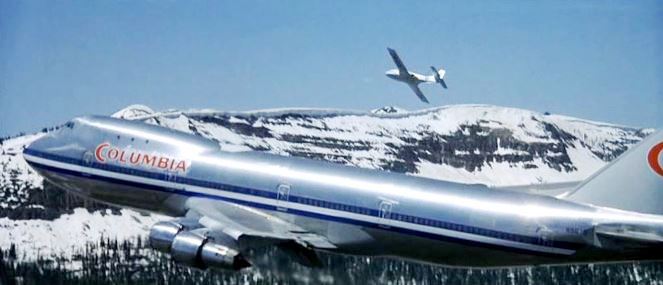
Philip Lathrop’s aerial photography of the grand 747 flying over the mountains and the stunt work here is so good, it quickly quells the shoddiness of the set-up. Murdock lands the plane, but malfunctioning brakes mean he has to careen around the airfield before finally grinding to a halt. The original film’s concentration on relationship dilemmas had by this time given way to disco-era sleaziness, as Thinnes and Estrada oil up flight attendants with eyes and quips, particularly neophyte Bette (Christopher Norris), in displays of cringe-inducing sexism. This does, however, distract from another theme percolating here—a dawning contemplation of the difficulties of more equal partnerships glimmering in the way Black’s servile stewardess, introduced arguing with Murdock, then has to step up to the plate in a deadly situation and keep her head. The series kept up its habit of inventing airlines for nasty things to befall; for the original, a fictional Trans Global Airways and Trans America had been created, and in Airport 1975, Columbia Air Lines. This was an inevitable nicety when dealing with this sort of thing, although the films also notably bend over backwards to emphasise just how durable and tough the aircraft are in bad expository dialogue.
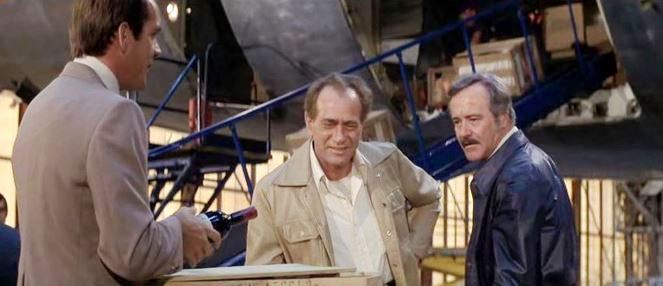
For all its silliness Airport 1975, although not as big a hit as the first film, brought back an amazing budget-to-box office ratio, making another entry inevitable. Airport ’77 is, by contrast, more polished and solidly conceived, easily sporting the best special effects of the series, as if the studio realised they needed to nurture this cash cow a bit more tenderly. Perhaps they also took a cue from Allen’s disaster films, making plot more important and putting greater emphasis on the mechanics of survival. Rather than just shoehorning someone like Swanson in, here the Old Hollywood star is James Stewart, cast as billionaire entrepreneur Philip Stevens, whose privately owned, specially built 747 is central to the storyline. For the sake of media coverage, Stevens has his chosen pilot, Capt. Don Gallagher (Jack Lemmon), fly the plane to his estate at Palm Beach with a load of celebrities and part of his valuable art collection. A number of thieves, colluding with Gallagher’s copilot, Chambers (Robert Foxworth), set out to hijack the plane mid-flight and abscond with the art: they knock out everyone aboard with gas, and Chambers steers for a remote island. On the way, he clips the top of an oil rig and crashes into the sea. Because of the plane’s special fittings, several compartments remain watertight, and the plane sinks to the shallow Caribbean floor with most of the people on board unharmed, but trapped. Gallagher has to work out some way of alerting rescuers to their position, and then just how to get them out of a tin can on the ocean floor becomes the concern of navy personnel, whilst Joe Patroni advises at Stevens’ side.
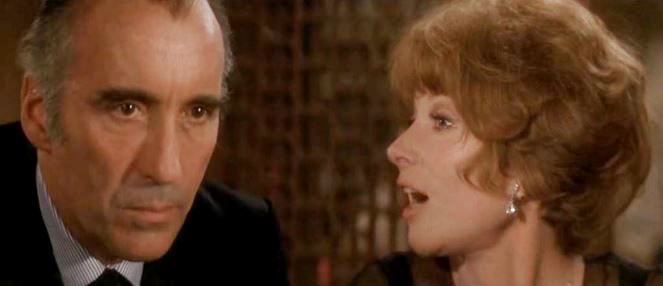
Airport ’77 proceeds with a more serious tone and tackles its slightly ridiculous central situation in a way that makes it feel tolerably believable, but still offers up some glorious hunks of cheese, chasing pathos in the form of blind lounge pianist Steve (Tom Sullivan) and adoring fan Julie (Kathleen Quinlan). Also on board are one of Stevens’ underlings, Stan Buchek (Darren McGavin); Stevens’ daughter, Lisa (Pamela Bellwood), and her son, who have established life out of the tycoon’s shadow; slick barman Eddie (Robert Hooks); and arts patron Emily Livingston (Olivia de Havilland), who finds herself flung back into the company of an old beau, Nicholas St. Downs (Joseph Cotton). The most vital characters here are Christopher Lee as Martin Wallace, an intensely committed underwater engineer and humanitarian, and his alcoholic wife, Karen (Lee Grant), who goads and insults her husband and has even slept with his assistant (Gil Gerard), but still, in her odd way, loves him obsessively. When the only option for escape seems to be a risky venture into the plane’s cargo hold to find and float a rescue beacon, Martin joins Gallagher, but drowns in the attempt when he opens a door to the sea, leaving Karen distraught. Grant’s magnificent overacting and Lee’s terse, earnest performance make for a heightened, highly entertaining study in contrasts, whilst their characters return to the motifs of unhappy couples in the original, playing what the Bakersfields’ marriage might have looked like if, instead of drifting apart, they’d been locked together in a perverse, even masochistic brand of affection. The problem here is that once Martin kicks the bucket and Karen zones out, Airport ’77 lacks anyone else interesting to focus on, as the other characters are too thinly sketched and played.
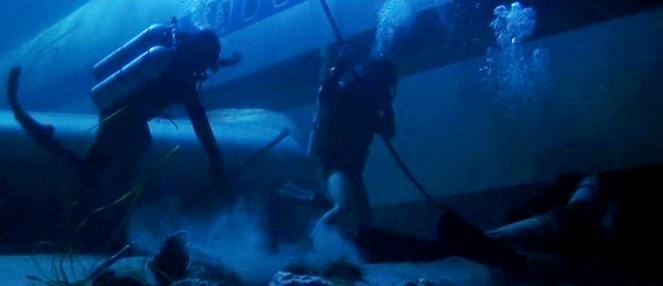
Casting Lemmon as Gallagher was a potentially interesting move in creating a hero in a different mould to the fantasy portraits in alpha masculinity hitherto seen, and his relationship with Eve Clayton (Brenda Vaccaro), another of Stevens’ aides, does feel distinctly warmer and more adult than most of the other couplings in the series. But Lemmon basically walks through the film when he’s not scuba diving, and I’d bet even money the chance to do something physical like that is the reason he accepted the role. Meanwhile, the old stars on show here—Stewart, De Havilland, and Cotton—basically get nothing to do. Even the screaming camp of Steve and Julie doesn’t sing as loudly as it should. It’s a sign of how lacking in pep the script is that it barely includes Patroni and can’t even provide anything for him to swear at. The director, Jerry Jameson, was another former TV hand who had also worked as an editor, but like his earlier horror film, Bat People (1974), and his later nautical project, Raise the Titanic (1979), he scarcely seems aware of how to dramatically shape a film, happy instead to offer up lots of B-roll footage of navy ships and scuba divers at work. This leaves Airport ’77 in a curious limbo: it’s better on almost all levels than Airport 1975, and yet, finally, much less entertaining. After the long, laborious finale when the navy does show up and sets about floating the plane to the surface, we’re assured the rescue techniques are all realistic, and indeed it does have the feel of watching someone’s manual acted out.
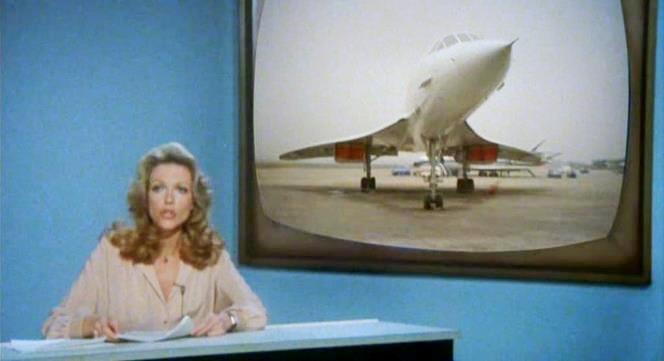
Nonetheless, Airport ’77 was still another substantial hit, and Jennings Lang eventually mustered the gall to produce one last episode. The Concorde… Airport ’79 came out in the waning months of the decade these films so exemplified. By this time, all hint of Hailey’s systemological and sociological interests were gone, but Patroni was still around, and finally comes into his own as central protagonist, albeit a little late. The Concorde bombed and brought the official series to an ignominious end. This swan song is incredibly silly, stretching several of the series’ regulation tropes to the point of cartoonishness. But it also has freewheeling pulp-novel jauntiness and a willingness to indulge its inanest ideas that makes it often riotously entertaining, if not always in a positive manner. The plot here strays into territory reminiscent of Hailey’s rival pop writers, Robert Ludlum and Alistair MacLean, revolving around tycoon arms manufacturer Kevin Harrison (Robert Wagner), who’s been selling weapons illegally. One of his minions, Carl Parker (Macon McCalman), approaches Harrison’s sometime girlfriend and TV journalist Maggie Whelan (Susan Blakely) with his collected evidence for Harrison’s activities, but a hired assassin guns down Carl and pursues Maggie around her house, eventually giving up and running away.

Maggie, scheduled to cover the inaugural run of a Concorde purchased by the airline owned by Eli Sands (Eddie Albert), embarks on the flight, but is given Carl’s evidence at the airport by his widow. Harrison, knowing this, immediately makes several attempts to destroy the flight in mid-air, including launching an experimental missile system at it, hiring a mercenary jet pilot to shoot it down, and finally, having agents sabotage the plane. Battling Harrison’s machinations are Patroni, who, looking for a challenge after his wife’s death, has returned to flying for Sands, and French copilot Paul Metrand (Alain Delon), who delivered the plane to the U.S. He partners with Patroni as they steer the plane to Moscow via Paris. On board this time are a bunch of Russian athletes bound for the 1980 Moscow Olympics, including champion gymnast Alicia Rogov (Andrea Marcovicci), who’s in love with one of Maggie’s colleagues, Robert Palmer (John Davidson), and Mercedes McCambridge playing her hard-bitten coach. Monica Lewis and Jimmie Walker appear as jazz musicians heading to a cultural festival before the Olympics, with Walker’s character, Boise, fond of getting high in the bathroom. Also in the cast for no particular reason are David Warner rounding out the flight crew, Cicely Tyson as an anxious mother escorting not a whole sick child but just the intended organ for a transplant, and Martha Raye and Charo adding comic relief, which is much less funny than the film’s serious stuff. Metrand is a dashing lothario contending with his own impending choice of continuing his wayward ways or settling down with stewardess Isabelle (Sylvia Kristel).

If the earlier entries in the series exemplified the apparent fantasy lives and yearnings of the era’s mass American audience, The Concorde tries to export the brand and lasso Delon and Kristel as avatars of an even more louche, free-and-easy continental lifestyle. The intended ooh-la-la jazz is lessened as Delon looks bewildered throughout and Kristel, well, can’t act. The filmmakers take this lifestyle target to the point where Metrand hires a hooker, Francine (Bibi Andersson), to pose as a perfect date for Patroni and help him get his mojo back, leading to an unforgettable scene with Kennedy and Andersson lounging in the buff under a lambs-wool blanket before an open fire. The experience leaves Patroni fired up again and cements his friendship with Metrand as they contend with Harrison’s attempts to kill them. Those attempts include a dizzyingly hilarious sequence in which Metrand flies the Concorde upside down whilst Patroni fires flares out the cockpit windows to distract heat-seeking missiles. To disassemble all the improbabilities in this scene would take a while; suffice to say that our heroes succeed and manage to land in Paris, although the Concorde is damaged and can’t brake, so the plane has to be caught in giant nets.
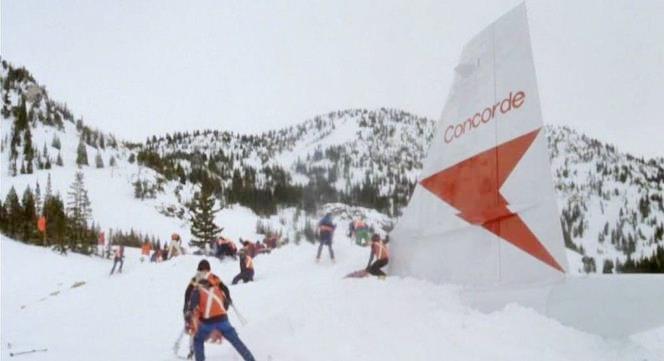
In spite of this mechanical complication, a couple of quick repairs later, the plane takes off again with Maggie still aboard, even though there’s a psychopathic tycoon trying to kill her. But everybody’s dedicated, dammit, and they’re going to finish the job they signed on for. Maggie is also friends with Patroni, and it’s signalled he could be a good fallback boyfriend after the prissy megalomaniac. The Concorde’s director was David Lowell Rich, another filmmaker who was jobbing around Hollywood for a long time and had staked his claim to taking on the series with the franchise imitation SST: Death Flight (1977). More interestingly and bewilderingly, the script was penned by Eric Roth, who would go on to pen Forrest Gump (1994), Ali (2001), and Munich (2005). Rich and Roth build to their climax, as sabotage causes a cargo bay door to fly off, forcing Mertrand and Patroni to land the ailing Concorde on a snow field. Mostly everyone escapes, and the film ends rather suddenly. The collection of good actors here picking up a quick paycheque is rather astounding. Blakely, in particular, deserved better, and where else can you see Delon, Kennedy, and Warner locked together in a small space?
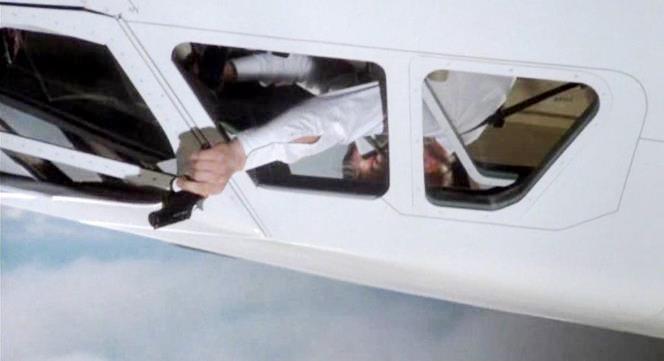
Still, The Concorde is so magnificently dumb, it’s a near-endless pleasure to me. But it was certainly a bridge too far for the series, which died here. History wasn’t on its side, with the oncoming Soviet invasion of Afghanistan and U.S. boycott of the Moscow Olympics, both of which made its lighthearted take on détente chic instantly dated. The flop of several competitors, including Irwin Allen’s The Swarm (1978) and When Time Ran Out… (1980), helped kill off the disaster movie craze, and Airplane! raked dirt over the grave. I also suspect a change of culture played a part, as the ’80s with Reaganism and AIDS saw the Me Decade fantasies at play here become recherché. But perhaps the biggest change that spelt the doom of this breed was cinematic. The arrival of Star Wars in 1977 has been blamed for helping kill the ambitious and personal cinema of the era, but, in fact, it was far more lethal to rival blockbuster films like the Airport series, which maintained their peculiar faith in those old cinema values like star power, no matter how they misused it. Although visual action in the Airport films is important to their plots, it’s obvious the filmmakers would always prefer to hire a name than spend the dime on an effect, and the effects in The Concorde are spectacular only in their lameness. But Star Wars filled theatres with special effects, not movie stars. I call it a slight pity, if only because maybe if there had been an Airport ’81, the filmmakers’ twinning urges towards trendiness and cliché might have finally given us a female pilot and her steward lover. The Airport films certainly don’t transcend their era, but as relics they still are fun.

You brought back every cringing memory of watching the series… but also every entertaining choice. And you point out quite convincingly that they are often the same moment. I’d like to nominate Naked Kennedy Fireside as most knowing high school band name, for whoever wants it. I came away from my semi-recent viewings glad to check them off the list, and thought I’d never return to them. Now, like you’ve done so often before, your clever writing has lit a strong urge to punish myself again.
LikeLike
“I’d like to nominate Naked Kennedy Fireside as most knowing high school band name, for whoever wants it”
You win the prize, Rob, the horrible, horrible prize. Also, Jean Seberg’s Scrambled Eggs might take second prize in that stakes. I did actually once do an impromptu comedy bit at a party years ago making sport of Charlton Heston’s smoked aviators and turtleneck. In any event, goofy as these are, I find they do lend themselves to occasional binge-watching in moments of intellectual and emotional powering down. So when you do revisit them, remember to curse my name.
LikeLike
Nominating AIRPORT alongside Patton, Love Story, Five Easy Pieces and MASH for the Best Picture prize of 1970 was overkill of a high order, yet today the enormously entertaining film is a guilty pleasure at worst and an engaging Hollywood disaster flick at best. My longtime site colleague, a European with a distinct cynical eye towards 70’s Hollywood refers to it as “shite”, but I sing a much different tune and much appreciate this extraordinary, albeit surprising analysis. Even Helen Hayes’ award winning performance is irresistible. yes I completely agree that it borrows heavily from THE HIGH AND THE MIGHTY. AIRPORT 75 is less, but still no throwaway.
LikeLike
I’ve long suspected, Sam, that the Best Picture nomination was a kind of tribal statement for Hollywood: a big, popular movie made by a well-respected producer in a year when a lot of its kin were falling by the wayside. No, the first one isn’t shite even if it’s really only swell entertainment. And really, who couldn’t love Helen Hayes?
LikeLike
coming in two weeks!……..
http://www.amazon.com/exec/obidos/ASIN/B01D9TA53U/dvdbeaver-20/ref=nosim
LikeLike
Incredible!
LikeLike